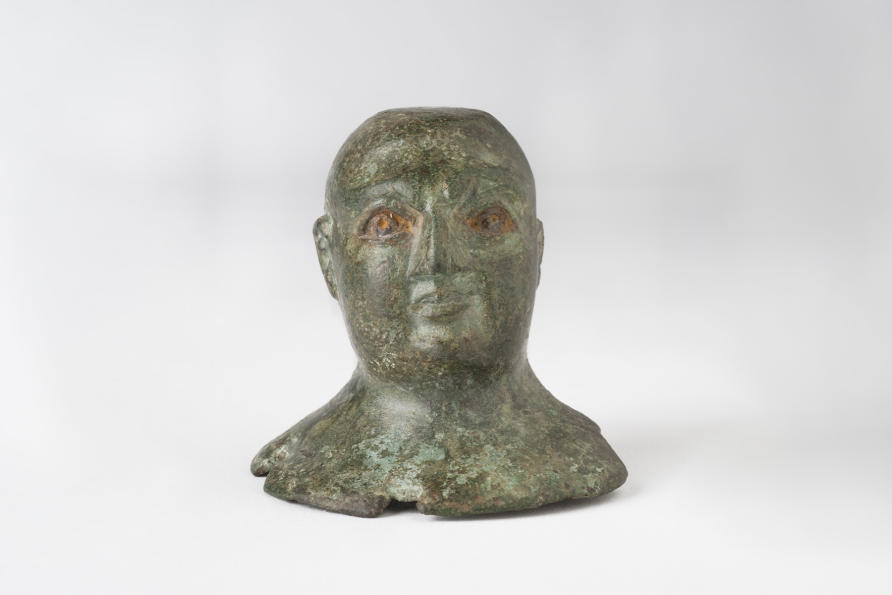Beauté, vin et mort dans le monde antique
Une nouvelle exposition donne un aperçu de la vie cachée des femmes, des enfants, des esclaves et des artisans de l'ancien monde gréco-romain
Par Dr Tamara Lewit et Dr Caroline Tully, Université de Melbourne
Imaginez une femme regardant son visage dans un petit miroir en laiton poli. Elle n’a jamais vu son corps dans son intégralité – aucun miroir n’est aussi grand dans les mondes grec et romain.
Elle blanchit son visage avec de la craie en poudre et rougit ses joues avec une teinture à base de garance. Ses doigts plongent dans un plat rond décoré d’un monstre marin fantaisiste à tête de cheval.
Nous pouvons rarement apercevoir les ateliers, les chambres et les infirmeries de ces peuples anciens ou la vie quotidienne cachée des femmes, des enfants, des esclaves ou des artisans qui ont laissé peu de traces et sont souvent ignorés dans l'écriture de l'histoire.
Ancient Lives: Insights from the Classics and Archaeology Collection, une nouvelle exposition en deux parties développée par le Ian Potter Museum of Art de l'Old Quad de l'Université de Melbourne, offre une rare fenêtre sur ces vies.
Le plat du monstre marin est l'un des nombreux petits objets personnels présentés dans une partie de l'exposition : Amor et Mors : Récipients pour le beau corps dans la vie et la mort.
Au lieu de craie et de teinture, peut-être que la femme devant le miroir utilise du céruse venimeux et du cinabre écarlate (sulfure de mercure) dans ses efforts pour rehausser sa beauté.
Le poète romain Ovide suggère un mélange d'orge libyenne broyée, de vesce amère, d'œufs et de premières cornes de cerf, mélangés à des bulbes de narcisse et du miel, afin que « toute femme qui applique ce traitement sur son visage brillera plus doucement que le sien ». miroir".
Un tel mélange aurait été stocké dans une pyxis, une petite boîte cylindrique ou convexe avec un couvercle, décorée d'animaux comme des sphinx et des lions et décorée de taches, de carrés et de gribouillis.
Les gens voulaient non seulement être beaux, mais aussi sentir divin. Un homme s’oindrait de parfum à la cardamome et d’huile capillaire parfumée provenant d’une bouteille en verre miniature – peut-être un nouveau type de bouteille, façonnée par des artisans avec leur souffle.
Le verre soufflé a été inventé au Proche-Orient au premier siècle avant notre ère (les premières preuves ayant été trouvées à Jérusalem) et a été importé à Rome par des artisans et des esclaves de la région.
Les parfums anciens étaient fabriqués à partir d’huile d’olive, d’amande ou de sésame mélangée à de la rose parfumée, de la coriandre ou du thym sauvage. Les parfums les plus chers contenaient de l'encens exotique, de la myrrhe, de la cannelle ou de la cassia, importés d'aussi loin que l'Arabie et l'Inde. Le patchouli indien a été récemment découvert dans un ancien flacon de parfum en Espagne.
Le parfum et la beauté n’étaient pas seulement destinés aux vivants mais aussi aux morts. Des huiles et des onguents parfumés étaient utilisés pour embellir le cadavre et offerts sur la tombe.
Le vin était une autre offrande importante, offerte aux morts lors des funérailles ou versée dans la tombe par des trous ou des tubes lors des anniversaires du défunt.
La deuxième partie de notre exposition, Blanc, fauve, rouge sang, noir : le vin dans les mondes grec et romain, explore comment les offrandes de vin aux dieux étaient également un élément essentiel de la religion, versées dans les sanctuaires domestiques chaque jour et lors d'occasions spéciales. comme le retour d'un voyage.
Les monnaies de l'exposition représentent des divinités et des empereurs accomplissant ces rites, qui étaient également accomplis par les plus humbles pêcheurs, jeunes filles ou ménagères.
Le vin était largement utilisé en médecine. Un manuel romain de remèdes maison recommande de se gargariser avec du fumier de pigeon moulu ou des mille-pattes écrasés dans du vin pour soulager les amygdales douloureuses.
Les vins aux herbes à base de menthe, de fenouil et d'absinthe (l'ingrédient principal de l'absinthe moderne) étaient utilisés pour soigner des affections telles que la toux et les maux d'estomac.
Un traité grec recommande même une injection de vin mélangé à du lézard haché comme aphrodisiaque pour les chevaux.
Mais le vin faisait également partie intégrante de l’alimentation de tous, même des enfants. Les auteurs médicaux recommandaient de sevrer les bébés en utilisant du pain ramolli dans du vin doux, car sans réfrigération, le lait se gâterait facilement.
Dr Caroline Tully and Dr Tamara Lewit Picture a woman gazing at her face in a small mirror of highly polished brass. She has never seen her whole body – no mirror is that large in the Greek and Roman worlds. She whitens her face with powdered chalk and reddens her cheeks with a dye made from the madder plant. Her fingers dip into a round dish decorated with a fanciful horse-headed sea monster. We can seldom glimpse the workrooms, bedrooms and sickrooms of such ancient people or the hidden everyday lives of women, children, slaves or artisans who have left little trace and are often ignored in the writing of history. Ancient Lives: Insights from the Classics and Archaeology Collection, a new two-part exhibition developed by the Ian Potter Museum of Art at the University of Melbourne’s Old Quad, gives a rare window into these lives. The sea-monster dish is one of the many tiny, personal objects featured in one part of the exhibition: Amor et Mors: Vessels for the Beautiful Body in Life and Death. Instead of chalk and dye, perhaps the woman at the mirror is using poisonous white lead and scarlet cinnabar (mercury sulphide) in her efforts to enhance her beauty. The Roman poet Ovid suggests a mixture of crushed Libyan barley, bitter vetch, eggs and the first horns of a stag, mixed with narcissus bulbs and honey, so that “any woman who applies this treatment to her face will gleam more smoothly than her own mirror”. Such a mixture would have been stored in a pyxis, a small cylindrical or convex box with a lid, decorated with animals like sphinxes and lions and patterned with spots, squares and squiggles. People not only wanted to look beautiful but also to smell divine. A man would anoint himself with cardamon perfume and scented hair oil from a miniature glass bottle – perhaps a new type of bottle, shaped by artisans with their breath. Blown glass was invented in the Near East in the first century BCE (the earliest evidence having been found in Jerusalem) and was brought to Rome by artisans and slaves from the region. Ancient perfumes were made using olive, almond or sesame oil mixed with fragrant rose, coriander or wild thyme. The most expensive perfumes contained exotic frankincense, myrrh, cinnamon or cassia, brought from as far as Arabia and India. Indian patchouli was recently discovered in an ancient perfume bottle in Spain. Perfume and beauty were not only for the living but also for the dead. Fragrant oils and unguents were used to beautify the corpse and were offered at the grave. Wine was another important offering, given to the dead during funerals or poured into the tomb through holes or tubes on the birthdays of the deceased. The second part of our exhibition, White, Tawny, Blood-red, Black: Wine in the Greek and Roman Worlds, explores how wine offerings to the gods were also an essential part of religion, poured at household shrines every day and on special occasions such as returning from a journey. Coins in the exhibition show deities and emperors performing these rites, which were also carried out by the humblest fishermen, young girls or farm housekeepers. Wine was used extensively in medicine. A Roman handbook of home remedies recommends gargling ground pigeon dung or crushed millipedes in wine for sore tonsils. Herbal wines made with mint, fennel and wormwood (the main ingredient of modern absinthe) were used to cure ailments including coughs and stomach upsets. One Greek treatise even recommends an injection of wine mixed with chopped up lizard as a horse aphrodisiac. But wine was also a universal part of the diet for everyone – even children. Medical writers recommended that babies be weaned using bread softened in sweet wine, since without refrigeration milk would easily spoil. Wine was always drunk diluted with at least three or four parts of water, except for religious rituals. Drinking water was often contaminated and was safer when mixed with wine, the acidic and alcohol content killing pathogens. Sour wine, which was virtually vinegar, was distributed as rations to Roman soldiers but would be considered undrinkable today, and slaves drank wine-like drinks made from the skins and pips of grapes soaked in water. Athletes were advised to drink wine only moderately. Wine is frequently referred to in the Christian Gospels, and the wine cup Jesus used at the ‘Last Supper’ came to be called the Holy Grail. According to medieval poetry and legend, it was also used to collect his blood and was much sought by the crusaders as a holy relic. Early Christian devotion is represented in the exhibition by a Tunisian plate fragment stamped with the image of a woolly lamb (a common early Christian symbol). Who stamped it and why? Was the artisan expressing piety or cleverly taking advantage of demand from adherents of this new religion? Perhaps its users felt protected by this sacred symbol as they reclined to dine, reaching into the communal dish of food with their fingers, as was the custom. Cups and jugs, gold coins and terracotta statuettes, a marble cupid, a bronze wrestler, glass bottles and cosmetic pots speak to us with the voices of ancient people about their intimate lives. The exhibition Ancient Lives: Insights from the Classics and Archaeology Collection is jointly curated by Dr Caroline Tully and Dr Tamara Lewit, and presents about 100 objects from the University of Melbourne Classics and Archaeology Collection. The exhibition forms part of the Ian Potter Museum of Art’s artistic program and is presented at the Old Quad while the Potter is undergoing transformation of its entrance and teaching spaces. It is open at the Old Quad, the University of Melbourne, Parkville, from 24 July 2023 – 17 May 2024, Monday to Friday 10-5. Entry is free. There are free Open Day curators’ talks at 11.30am on Sunday 20 August 2023. Banner: The serene face of a dead woman, lips tinted pink and eyes outlined with kohl, gazes at us from this mummy mask. Installation view, Ancient Lives, Old Quad, 2023. Courtesy of Museums and Collections Department, the University of Melbourne. Photo: Christian Capurro.Beauty, wine and death in the ancient world
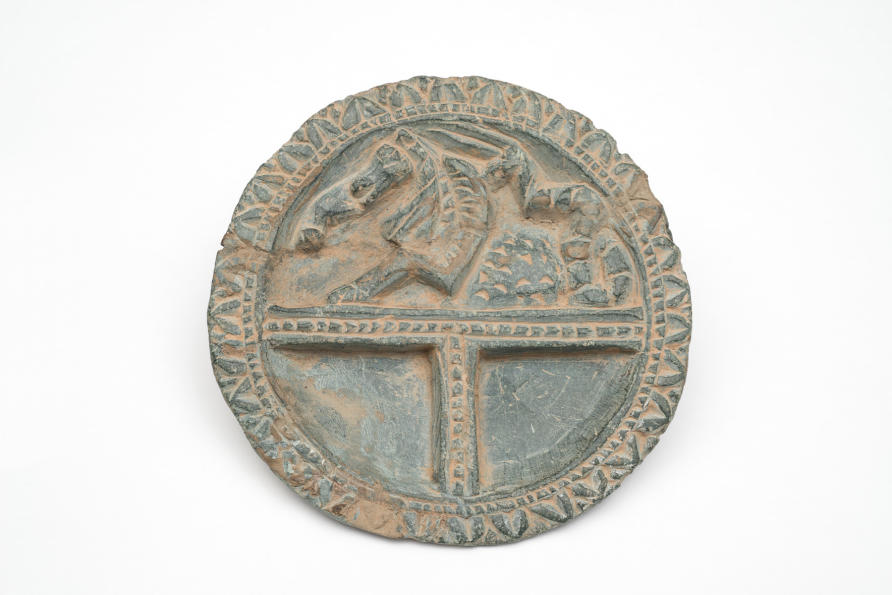
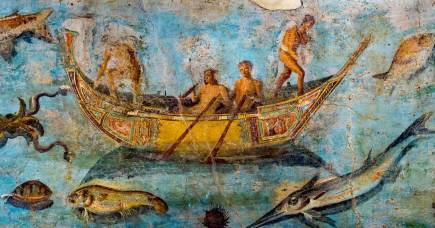
All rivers lead to Rome
LIFE, DEATH AND BEAUTY
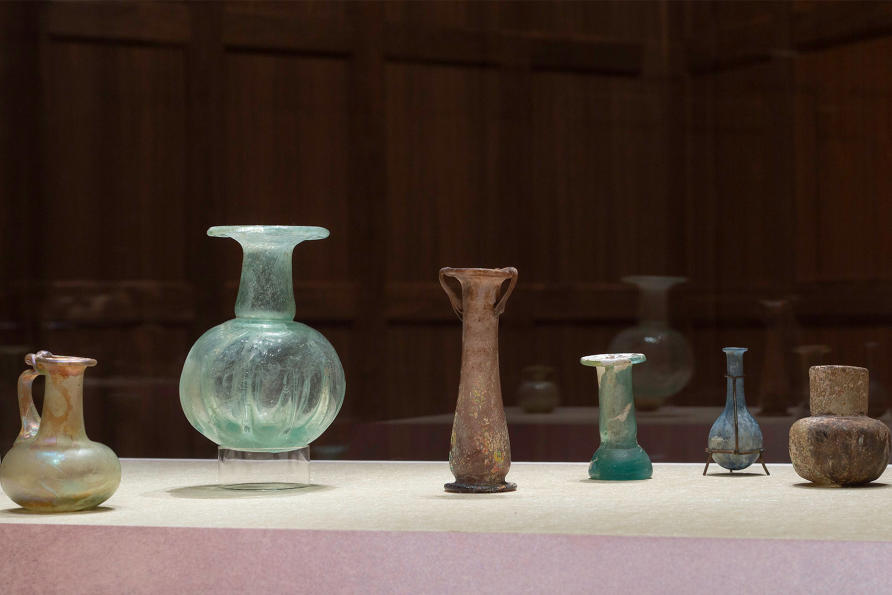
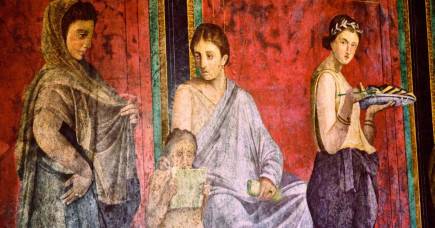
Happy ancient Roman Mother's Day
WINE FOR THE LIVING AND THE DEAD – AND BABIES
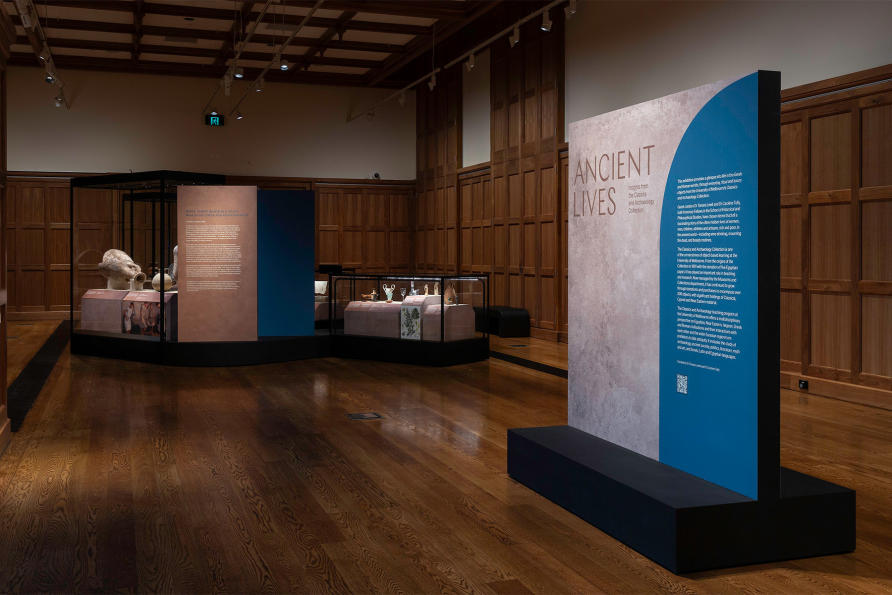
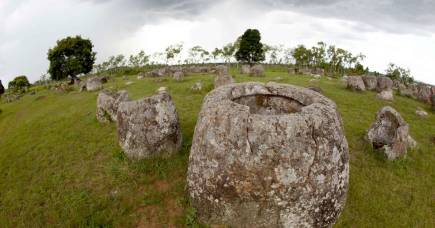
Laos jars are slowly revealing their secrets
